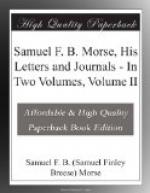“His original intention was simply to complete such parts of the figure as were useful in the single view necessary for the purpose of painting; but, having done this, he was encouraged, by the approbation of Allston and other artists, to finish the entire figure.
“After completing it, he had it cast in plaster of Paris and carried it to show to West, who seemed more than pleased with it. After surveying it all round critically, with many exclamations of surprise, he sent his servant to call his son Raphael. As soon as Raphael made his appearance West pointed to the figure and said: ’Look there, sir; I have always told you any painter can make a sculptor.’
“From this model Morse painted his picture of the ‘Dying Hercules,’ of colossal size, and sent it, in May, 1813, to the Royal Academy Exhibition at Somerset House.”
The picture was well received. A critic of one of the journals of that day in speaking of the Royal Academy thus notices Morse:—
“Of the academicians two or three have distinguished themselves in a preeminent degree; besides, few have added much to their fame, perhaps they have hardly sustained it. But the great feature in this exhibition is that it presents several works of very high merit by artists with whose performances, and even with whose names, we were hitherto unacquainted. At the head of this class are Messrs. Monroe and Morse. The prize of history may be contended for by Mr. Northcote and Mr. Stothard. We should award it to the former. After these gentlemen Messrs. Hilton, Turner, Lane, Monroe, and Morse follow in the same class.” (London “Globe,” May 14, 1813.)
[Illustration: THE DYING HERCULES Painted by Morse in 1813]
In commemorating the “preeminent works of this exhibition,” out of nearly two thousand pictures, this critic places the “Dying Hercules” among the first twelve.
On June 13, 1813, Morse thus writes to his parents:—
“I send by this opportunity (Mr. Elisha Goddard) the little cast of the Hercules which obtained the prize this year at the Adelphi, and also the gold medal, which was the premium presented to me, before a large assembly of the nobility and gentry of the country, by the Duke of Norfolk, who also paid me a handsome compliment at the same time.
“There were present Lord Percy, the Margravine of Anspach, the Turkish, Sardinian, and Russian Ambassadors, who were pointed out to me, and many noblemen whom I do not now recollect.
“My great picture also has not only been received at the Royal Academy, but has one of the finest places in the rooms. It has been spoken of in the papers, which you must know is considered a great compliment; for a young artist, unless extraordinary, is seldom or never mentioned till he has exhibited several times. They not only praise me, but place my picture among the most attractive in the exhibition. This I know will give you pleasure.”




